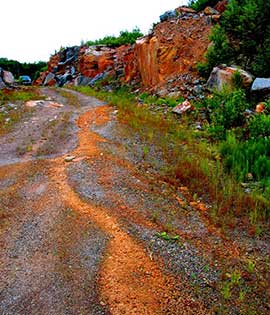
Acid Rock Drainage

Some bedrock contains minerals that can generate acid rock drainage (ARD). Typically in Nova Scotia, ARD occurs when pyrite and other sulphide minerals are exposed to water and oxygen, and react in a chemical oxidation process that releases sulphuric acid and metal oxides into watercourses downstream. The acidic runoff can mobilize metals, including heavy metals, such as iron, arsenic, manganese, and copper from the surrounding bedrock, releasing them into the environment as well. Similarly, ARD can develop from exposed surficial material and soils containing weathered sulphide-bearing bedrock.
Exposing and physically disturbing sulphide-bearing rocks can cause acid rock drainage to develop and can negatively impact the environment, human health and infrastructure. Acidic runoff, with pH levels as low as 3, can be harmful for aquatic habitats and can cause fish kills. ARD can contaminate drinking water supplies with increased concentrations of toxic and carcinogenic heavy metals. The acidity can corrode metal water mains, further leaching lead, copper and zinc into water supplies. Concrete foundations and bridges, metal culverts and pipes, and buried wiring are examples of infrastructure that ARD can corrode and degrade, causing maintenance and replacement costs to increase.
With numerous negative effects and costly remediation associated with ARD issues, it is favourable to be proactive when working with sulphide-bearing bedrock. The best way to prevent ARD from developing is knowing where sulphide-bearing bedrock is located and avoiding activities that expose or break it up, such as blasting, quarrying and excavating. In many cases, bedrock with high concentrations of sulphide minerals can be identified with geological mapping. The NR&R has produced maps showing the potential of bedrock ARD in southwestern Nova Scotia and the Halifax Regional Municipality. If disturbance is unavoidable, rocks and surficial materials with sulphide content equal or greater than 0.4 weight percent must be managed in accordance with The Sulphide Bearing Material Disposal Regulations (made under Section 66 of the Nova Scotia Environment Act 1995).


